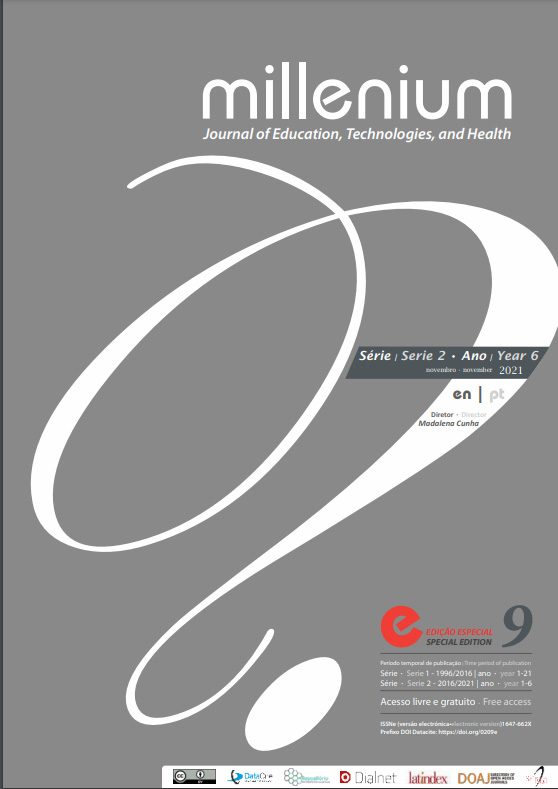Perfil dos estudantes do Instituto Politécnico de Viseu
estudo evolutivo desde o Tratado de Bolonha
DOI:
https://doi.org/10.29352/mill029e.24879Palavras-chave:
ensino superior, estudantes IPV, perfil alunosResumo
Introdução: Este trabalho pretende fazer uma caracterização do aluno típico do Instituto Politécnico de Viseu (IPV), em geral, e de cada Unidade Orgânica (UO), em particular. Nunca antes foi efetuado um estudo abrangente que descrevesse a origem demográfica dos alunos, o modo como entram no IPV, qual o tipo de curso e qual o curso escolhido. Além disso, procura associações relevantes entre algumas destas características. Este estudo permite, por um lado, conhecer o perfil dos alunos do IPV e, por outro, desenvolver estratégias de captação de novos alunos.
Objetivos: Caracterizar os alunos matriculados, pela primeira vez, no Instituto Politécnico de Viseu, desde o início do Tratado de Bolonha, ou seja, desde o ano letivo de 2006/2007 e até ao ano letivo de 2020/2021.
Estabelecer o perfil dos alunos de IPV, em geral, e dos alunos de cada Unidade Orgânica, em particular:
- ESEV (Escola Superior de Educação de Viseu)
- ESAV (Escola Superior Agrária de Viseu)
- ESSV (Escola Superior de Saúde de Viseu)
- ESTGV (Escola Superior de Tecnologia e Gestão de Viseu)
- ESTGL (Escola Superior de Tecnologia e Gestão de Lamego)
Métodos: Com recurso à estatística descritiva e inferencial, fazer uma avaliação sobre os alunos que foram ingressando no IPV desde o Tratado de Bolonha. Descrição e análise sociodemográfica dos alunos, bem como o tipo de curso procurado no IPV, em geral, e nas UOs, em particular. O estudo é complementado com a descrição e análise da forma de ingresso dos alunos nas licenciaturas.
Resultados: De entre as conclusões retiradas destacamos que entre 2006/2007 e 2020/2021, inscreveram-se, no IPV, 10573 (44.4%) homens e 13219 (55.6%) mulheres. Em média, os alunos tinham 23.21 anos com desvio padrão de 7.56 anos.
Relativamente ao distrito de proveniência dos alunos, a maioria vem de Viseu (61.5%), mas os distritos de Aveiro (10.5%), Porto (5.2%) e Guarda (5.0%) contribuem com uma percentagem significativa de alunos para o IPV.
Quanto às NUTSIII, mais de metade dos alunos provém de Viseu Dão Lafões (51.5%), sendo que o Douro (11.7%), Área Metropolitana do Porto (5.8%), Região de Aveiro (6.6%) e Beiras e Serra da Estrela (4.7%) são unidades de onde provém um número significativo de alunos.
A forma de ingresso nas licenciaturas e o género estão relacionados (p-value=0.000). Apesar da relação ser fraca (18.4%), há mais homens a entrarem pelos CTeSP/CET, Maiores de 23 e transferência (69.5%, 55.9% e 61.3%, respetivamente), e mais mulheres a entrarem pelo concurso nacional de acesso (62.3%).
Relacionando a idade e a forma de ingresso nas licenciaturas, verifica-se a existência de relação significativa (p-value=0.000) e forte (62.8%).
Conclusões:Como expectável, a maior parte das pessoas com mais de 35 anos entram por Maiores de 23 (61.3%) e a maior parte das pessoas até 22 anos (inclusive) entram pelo concurso nacional de acesso (90.9%).
Conclusões similares foram retiradas para todas as unidades orgânicas do IPV.
Downloads
Referências
Almeida, S., Vasconcelos, R., Machado, C., Soares, A., & Morais, N. (2002). Perfil Escolar e Socio-demográfico dos candidatos ao Ensino Superior: o caso dos estudantes da Universidade do Minho. CIPsi - Livros de atas. Universidade do Minho: Universidade do Minho.
Alves, M., & Lopes, P. (2015). Ensino Superior em Portugal: Retrato Sociográfico. Lisboa: Gabinete de Estudos SNESUP.
Fonseca, M., & Encarnação, S. (2012). O Sistema de Ensino Superior em Portugal - Perfis Institucionais: Os Institutos Politécnicos Públicos. Lisboa: Agência de Avaliação e Acreditação do Ensino Superior.
Maroco, J. (2019). Análise Estatística com o SPSS Statistics. Lisboa: Report Number.
MCTES, G. d. (2019). Relatório sobre o Acesso ao Ensino Superior. Lisboa: MCTES.
Downloads
Publicado
Como Citar
Edição
Secção
Licença

Este trabalho encontra-se publicado com a Licença Internacional Creative Commons Atribuição 4.0.
Os autores que submetem propostas para esta revista concordam com os seguintes termos:
a) Os artigos são publicados segundo a licença Licença Creative Commons (CC BY 4.0), conformando regime open-access, sem qualquer custo para o autor ou para o leitor;
b) Os autores conservam os direitos de autor e concedem à revista o direito de primeira publicação, permitindo-se a partilha livre do trabalho, desde que seja corretamente atribuída a autoria e publicação inicial nesta revista.
c) Os autores têm autorização para assumir contratos adicionais separadamente, para distribuição não-exclusiva da versão do trabalho publicada nesta revista (ex.: publicar em repositório institucional ou como capítulo de livro), com reconhecimento de autoria e publicação inicial nesta revista.
d) Os autores têm permissão e são estimulados a publicar e distribuir o seu trabalho online (ex.: em repositórios institucionais ou na sua página pessoal) já que isso pode gerar alterações produtivas, bem como aumentar o impacto e a citação do trabalho publica
Documentos necessários à submissão
Template do artigo (formato editável)





